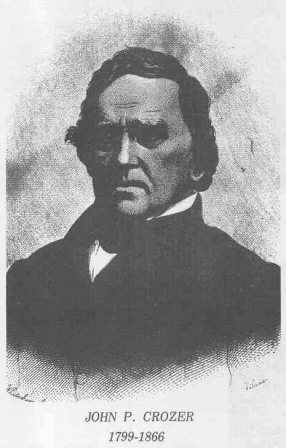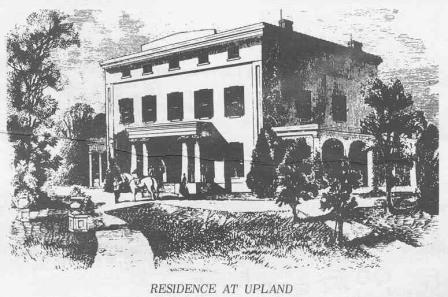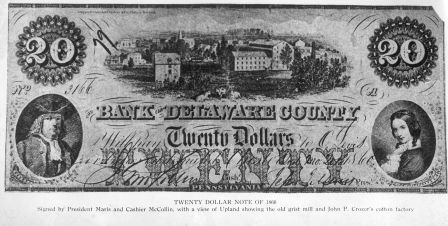19th Century
Chester Mills continued to be moderately successful as a "merchant milling" operation, but it appeared as though lumber was to be the growth business in this area, so the Flowers completed the installation of a new saw mill at Chester Mills in 1811. By 1813, certainly by 1815, Chester mills had ceased to function as a flour milling center, but did continue to grow its lumber cutting function. Many of these changes were being driven by the growing cotton and woolen industries and the serious risks associated with dealing in flour for export. In 1824 William Graham Flower was operating the saw mill at Chester Mills and advertising ash planks and other assorted lumber for sale at his mill. However, after this year, he no longer offered lumber for sale from this location. He moved it to Chester for sale. Other merchants were selling "Susquehanna" lumber from locations in Chester, and nobody wanted to come the two miles up the creek to get it from Chester Mills. By 1826 the Chester Mills ground grain occasionally, but they cut an average of 310,000 board feet of lumber per year. In 1839 William Flower, still the owner/investor in the Chester Mills lumber operations, suffered a financial loss when 50,000 board feet of lumber was swept away at Chester Mills in a flash flood. On July 24, 1843 Richard Flower died leaving a mortgaged mill, six heirs and no will, and the trustee for the estate was Edward Darlington. On August 5, 1843 the Chester Mills are again severely damaged by another flash flood. Richard Flower's estate was first advertised for sale on June 14, 1844.
 In March of 1845 Mr. John P. Crozer purchased from John W. Ashmead the Flower estate of some 65+ acres. At the time of this purchase John P. Crozer and his wife still were living in Crozerville on the west bank of the Chester creek.
In March of 1845 Mr. John P. Crozer purchased from John W. Ashmead the Flower estate of some 65+ acres. At the time of this purchase John P. Crozer and his wife still were living in Crozerville on the west bank of the Chester creek.
"In 1845, after the purchase from John W. Ashmead of the Chester Mills, John P. Crozer immediately made preparation for erecting a cotton-factory. The following year he built the mill known as No. 1, a five-story stone structure, one hundred and thirty-eight feet in length by fifty feet in width, and also erected a number of stone dwelling-houses for the mill workers. In June, 1847, there were forty-six tenements on the property, and an eighty horse-power engine had been attached to the factory, so that in the event of the water in the creek at any time proving insufficient to operate the machinery the mill would not be compelled to suspend operations. At that time there were one hundred and fifty power-looms, eleven self-acting mules, with three thousand eight hundred and sixty-four spindles, while the whole number of spindles amounted to six thousand. This mill was enlarged and contained eight thousand nine hundred and eighty-eight throstle-spindles, two thousand nine hundred and ninety-two mule-spindles, and two hundred and ninety-eight looms. In 1852, John P. Crozer built mill No. 2, one hundred and fifty-eight feet in length by fifty-two feet in width, four stories and an attic in height. It contained seven thousand spindles and one hundred and fifty looms. This mill, after it passed to Samuel A. Crozer, was enlarged, to contain seven thousand four hundred and fifty-six throstle-spindles, four thousand four hundred mule-spindles, and nine cards. In 1863, to meet the demand for the goods he then manufactured, John P. Crozer erected mill No. 3, fifty-two feet by two hundred and twenty-two feet, four stories in height, in which were used six thousand spindles and one hundred and fifty looms. This mill contained seven thousand one hundred and forty throstle-spindles, two thousand one hundred and twelve mule-spindles, and two hundred and fifty-six looms. Mills No. 1 and No. 3 had the capacity to consume ninety bales of cotton weekly, and produce eighty-two cases of goods per week. William I. Woodward was the manager of the mills of John P. Crozer's Sons. After the death of Mr. Crozer, in 1866, the mills were divided among his sons, Samuel A. Crozer taking No. 2 mill, and Nos. 1 and 3 being operated by J. Lewis, George K. and Robert H. Crozer, under the firm-name of J. P. Crozer & Sons."
In 1847, John P. Crozer relocated his family from Crozerville to their newly built home at Chester Mills, which he and his wife immediately renamed Upland due to their respect for the ancient name's history and the story of the place.
(And here is the beginning of the Village of Upland.)

Although the site of the first mills erected in the province of Pennsylvania after the territory passed into the ownership of Penn were located within this municipal district, it nevertheless remained a part of the township of Chester until May 24, 1869, when the borough of Upland was incorporated by the Court of Common Pleas of Delaware County. The boundaries of the municipality were described in the order as follows:
"Beginning at a point on the north side of the Upland road where it crosses a stream of water called 'Ship Creek', thence down the said Ship Creek, the several courses thereof, about eighty perches, to the east side of Chester Creek, at low-water mark; thence up the said creek at low-water mark, and on a line of the city of Chester, five hundred and eighty perches, to a stone on the east bank of the said Chester Creek, a corner of William West's land; thence by said West's land north nineteen and one-half degrees, east seventy-four perches and seventy-three one-hundredth of a perch to a stone; thence north eighteen and a half degrees, east ninety-six perches and three-tenths of a perch to a stone by William Maris' land; thence south seventy-three and a half perches, east ninety-seven perches, to a stone a corner of Abraham Lukens' land; thence by the said Lukens' land north twenty and three-fourth degrees, east forty-eight perches and seven-tenths of a perch to a stone a corner of Richard Wetherill's land; thence by the same south seventy-two degrees, east thirty perches and twenty-eight one-hundredths of a perch to another corner of said Wetherill's land; thence by the same north twenty-three degrees, east thirty-six perches and fifty-two one-hundredths of a perch to a stone another corner of the said Wetherill's land; thence by and through the same and through lands of J. Lewis Crozer south sixty-four degrees, east ninety-two perches to a stake in the west line of Chester Rural Cemetery; thence by the said cemetery south twenty-six and a half degrees, west forty perches and eight-tenths of a perch to a post on the north side of the Chester and Upland road; thence along the north side of the said Upland road south seventy-two and a half degrees, east eighty perches, and north seventy-one and three-fourth degrees, east seventeen perches, and thirty-four one-hundredths of a perch, to the place of beginning, containing three hundred and thirty-five acres of land."
Ten years subsequent to the erection of the borough, on Sept. 18, 1879, the court made an order adding to the incorporated area of the borough of Upland as follows:
"Beginning at a stone a corner of Abraham C. Lukens' land, and a corner of the said borough of Upland; thence partly by the said borough of Upland, and partly by the borough of North Chester, north twenty and one-half degrees, east ninety-four perches and fifteen one-hundredths of a perch to a stone, a corner of the said Abraham C. Lukens' land; thence partly by the same and partly by lands of the heirs of Jesse J. Maris, deceased, north seventy-seven degrees, west one-hundred and thirty perches and three-tenths of a perch to a stone; thence by lands of the said Jesse J. Maris, deceased, south five and one-fourth degrees, west eighty-five perches to a corner, a stone by Samuel A. Crozer's land, in a line of the said Upland borough; thence south seventy-three degrees, east ninety-seven perches, to the place of beginning, containing sixty-five acres two roods thirteen perches, thirty-nine acres two roods and two perches thereof being lands of the heirs of Jesse J. Maris, deceased, and twenty-six acres and eleven perches being lands of the said Abraham C. Lukens."
Ashmead's 1884 History of Delaware County points out the following about the village of Upland; "Forty years ago (1844) the site of the thriving Borough of Upland was occupied only by the mansion-house of the then owner of the land, six tenement-houses for the mill-hands, a cooper-shop, a four-story stone grist-mill, and a frame saw-mill, with the usual out houses on ordinary farms. To-day (1884) it is one of the neatest manufacturing villages in the United States, containing a population approximating three thousand persons.

On the hill crests to the north of the village are located the palatial residences of the Crozer family, the well-kept grounds adding largely to the attractiveness of the place. The Chester Street Railway Company has extended its road to Upland, which affords easy access to the city and the mills, and many of the private residences and stores are supplied with gas by the Chester Gas Company. In 1854 the Bank of Delaware County issued notes of the denomination of twenty dollars, on which were engraved a view of Upland as a vignette. At the present time (1884) the same engraving is used as a head-piece on certificates of stock issued by that corporation."

